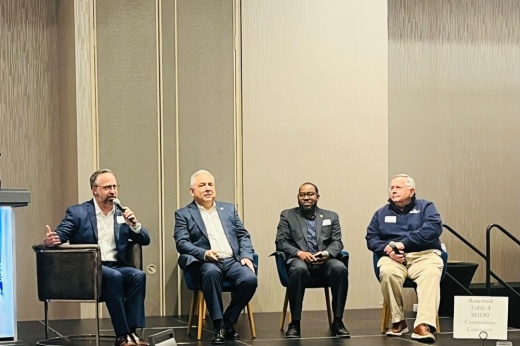The panel addressed the corridor’s emerging status as "the new I-35," highlighting the roadway’s contribution to economic growth.
The gist
The mayors of Pflugerville, Lockhart and Manor provided insights into the history and early stages of development for the roadway. Additionally, representatives from various industrial and mixed-use development firms elaborated on the potential impact and significance of the corridor.
Concluding the panel discussion, Gary Farmer, president of Heritage Title Company of Austin, and San Antonio politician Henry Cisneros shared their vision of how SH 130 will eventually link Austin and San Antonio, akin to the connectivity seen in the Dallas-Fort Worth metropolitan area.
Sorting out the details
Some of the biggest takeaways from the discussion involved the pressing need to expand the arterial road systems surrounding SH 130, as the highway has brought in an explosion of growth in recent years, Lockhart Mayor Lew White said.
“I don't go a week without getting an angry text from somebody sitting out in traffic waiting at a [SH 130] intersection,” White said.
He explained that the majority of Lockhart residents are commuters, as many large tech companies—like Samsung and Tesla—are now located along SH 130 near Austin. However, these smaller communities are finding it difficult to get Texas Department of Transportation funding for the smaller road systems maintained by the state.
“When it comes to TxDOT, the competition that we face is always so great,” White said. “They're telling us that we have to bear more of the expense.”
Manor Mayor Chris Harvey shared a similar sentiment, saying Hwy. 290—the city’s main thoroughfare—desperately needs to be expanded to a six-lane road to accommodate the increased traffic off the toll road and support Manor’s ongoing growth.
“I think our challenge has been really trying to get to the table so that we can explain what's happening in our area, ... trying to get a message back to TxDOT and other entities from the state,” Harvey said. “I-35 has gotten a lot of attention and money. ... We want to be able to commute back and forth, and do what we need to do. We don't want to go to work and have 45-60 minutes to get back to our community.”
The framework
SH 130 is a 91-mile toll road parallel to I-35, intended to facilitate growth and long-distance travel between Mexico and the Midwest, while providing additional capacity for local travel, according to TxDOT.
In 2003, the state Legislature passed a law allowing TxDOT to partner with the private sector to help develop important transportation improvements. Construction on the SH 130 toll began within the same year as a result of these partnerships.
The $1.35 billion project opened the full stretch of roadway—from north of Georgetown down to San Antonio—to traffic in October 2012 as the first privately developed highway in Texas.
TxDOT set an 85 mph speed limit—the highest in the United States—to increase the road’s appeal as an alternate route to I-35.
Put in perspective
Amy Madison, executive director of Pflugerville Community and Development Corp., previously told Community Impact the toll road has attracted technology and manufacturing jobs to the city of Pflugerville.
“You’ve got to have roads [and] utilities to do anything,” Madison said. “... That’s what SH 130 brought for all of us, the entire region.”
Developers also discussed how areas with large economic development impacts, such as The Domain in Austin, are a result of transportation initiatives and access.
Ben Bufkin, a managing principal who co-led the development of The Domain into today’s well-know retail destination, said partnerships between the private sector and local municipalities for transportation projects is a “benefit to all.”
Bufkin said introducing affordable housing to the SH 130 corridor will foster a thriving employment sector as well as stimulate further growth in commercial and retail development.
Industrial developers Davis Bass with HPI’s Industrial Development and Whitney Williamson with Prologis spoke about the corridor in terms of the vast amounts of large properties available for advanced manufacturing sites.
These increased industrial developments along SH 130 bring a unique feature to the corridor, Bass said.
“Looking at the benefit to the community, these building projects that we've been able to do—they're attracting new talent to the region. We’re going to see higher-quality people [with valuable skill sets] that trickle down into the schools and the other [employment sectors],” Bass said.
Looking ahead
Large developments like Samsung have forced infrastructure and growth eastward, Bufkin said, adding that the international investments within Central Texas—particularly the SH 130 corridor—are huge in terms of the area’s global presence.
Farmer said in the last 40 years the Austin area has been one of the most prolific creators of jobs across the nation.
A December report from economic development organization Opportunity Austin ranked the Austin-Round Rock Metropolitan Statistical Area as the best performing economy among the 50 largest metros in the U.S. for 2022.
"Did the road make the region or did the region make the road?” Farmer said.
As the region and corridor continue to see growth, Cisneros' vision for the corridor aims to connect Austin and San Antonio to form a metropolitan area. He noted the tollway has encouraged collaboration among the numerous municipalities along the corridor, leading to mutually beneficial developments throughout the region.
“I predict that what's going to happen is that the territory between I-35 and SH 130 will be the most desirable real estate in America,” Cisneros said.





